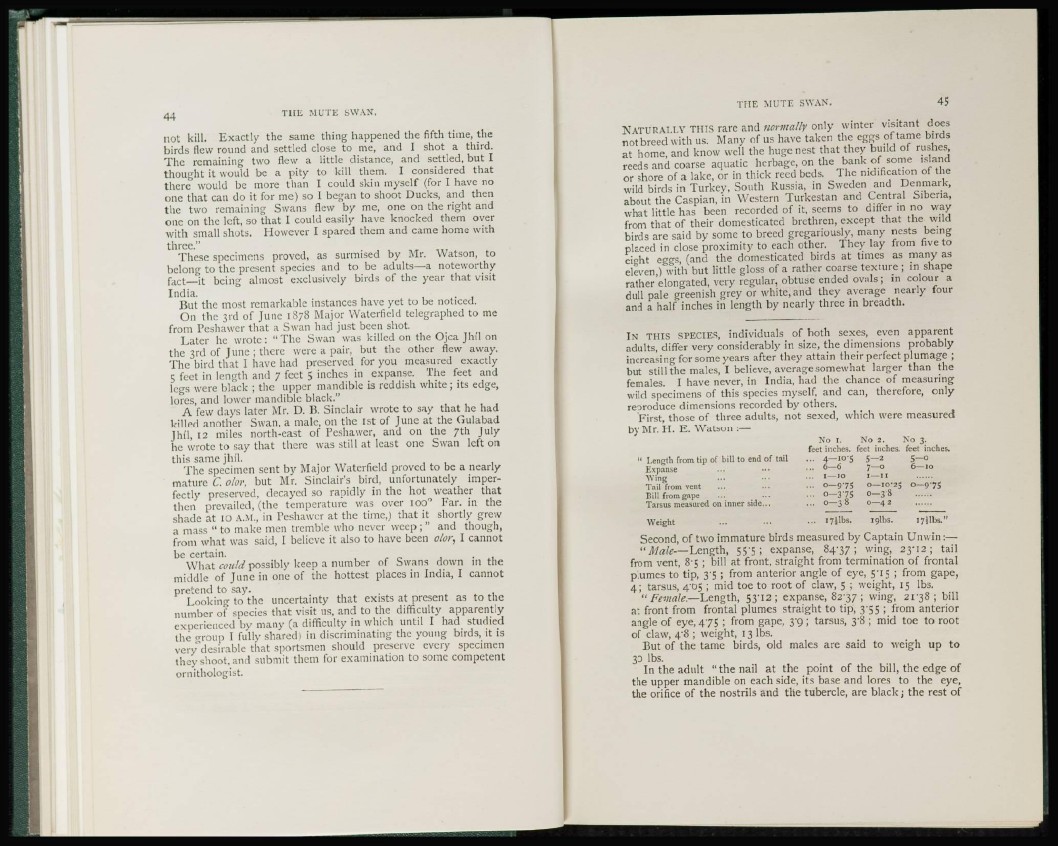
44 THE MUTE s w a n.
not kill. Exactly the same thing happened the fifth time, the
birds flew round and settled close to me, and I shot a third.
The remaining two flew a little distance, and settled, but I
thought it would be a pity to kill them. I considered that
there would be more than I could skin myself (for I have no
one that can do it for me) so I began to shoot Ducks, and then
the two remaining Swans flew by me, one on the right and
one on the left, so that I could easily have knocked them over
with small shots. However I spared them and came home with
three."
These specimens proved, as surmised by Mr. Watson, to
belong to the present species and to be adults—-a noteworthy
fact—it being almost exclusively birds of the year that visit
India.
But the most remarkable instances have yet to be noticed.
On the 3RD of June 1878 Major YVaterfield telegraphed to me
from Peshawer that a Swan had just been shot.
Later he wrote: "The Swan was killed on the Ojca Jhil on
the 3RD of June ; there were a pair, but the other flew away.
The bird that I have had preserved for you measured exactly
5 feet in length and 7 feet 5 inches in expanse. The feet and
legs were black ; the upper mandible is reddish white; its edge,
lores, and lower mandible black."
A few days later Mr. D. B. Sinclair wrote to say that he had
killed another Swan, a male, on the 1ST of June at the Gulabad
J tail, 12 miles north-east of Peshawer, and on the 7TH July
he wrote to say that there was still at least one Swan left on
this same jhil.
The specimen sent by Major Waterfield proved to be a nearly
mature C. olor, but Mr. Sinclair's bird, unfortunately imperfectly
preserved, decayed so rapidly in the hot weather that
then prevailed, (the temperature was over ioo" Far. in the
shade at 10 A.M., in Peshawer at the time,) that it shortly grew
a mass " to make men tremble who never weep ; " and though,
from what was said, I believe it also to have been olor, I cannot
be certain.
What could possibly keep a number of Swans down in the
middle of June in one of the hottest places in India, I cannot
pretend to say.
Looking to the uncertainty that exists at present as to the
number of species that visit us, and to the difficulty apparently
experienced by many (a difficulty in which until I had studied
the group I fully shared) in discriminating the young birds, it is
very desirable that sportsmen should preserve every specimen
they shoot, and submit them for examination to some competent
ornithologist.
THE MUTE SWAN. 45
NATURALLY THIS rare and normally only winter visitant does
not breed with us. Many of us have taken the eggs of tame birds
at home, and know well the huge nest that they build of rushes,
reeds and coarse aquatic herbage, on the bank of some island
or shore of a lake, or in thick reed beds. The nidification of the
wild birds in Turkey, South Russia, in Sweden and Denmark,
about the Caspian, in Western Turkestan and Central Siberia,
what little has been recorded of it, seems to differ in no way
from that of their domesticated brethren, except that the wild
birds are said by some to breed gregariously, many nests being
placed in close proximity to each other. They lay from five to
eight eggs, (and the domesticated birds at times as many as
eleven,) with but little gloss of a rather coarse texture ; in shape
rather elongated, very regular, obtuse ended ovnls; in colour a
dull pale greenish grey or white, and they average nearly four
and a half inches in length by nearly three in breadth.
IN THIS SPECIES, individuals of both sexes, even apparent
adults, differ very considerably in size, the dimensions probably
increasing for some years after they attain their perfect plumage ;
but still the males, I believe, average somewhat larger than the
females. I have never, in India, had the chance of measuring
wild specimens of this species myself, and can, therefore, only
reproduce dimensions recorded by others.
First, those of three adults, not sexed, which were measured
by Mr. H. E. Watson :—
No I. No 2. No 3.
feet inches, feet inches, feet inches.
" Length from tip of bill to end of tail ... 4—10-5 5—2 5—o
Expanse ... ... ... 6—6 7—o 6—10
"Wing ... ... ... I —10 I — II
Tail from vent ... ... ... o—975 o—10-25 0—975
Bill fromgape ... ... ... o—375 o—38
Tarsus measured on inner side... ... O—38 0—42
Weight ... ... ... L7JLBS. I9lbs. I7jlbs."
Second, of two immature birds measured by Captain Unwin :—
"Male—Length, 55'5 ; expanse, 84V37; wing, 2 3 ' I 2 ; tail
from vent, 8-5 ; bill at front, straight from termination of frontal
plumes to tip, 3-5 ; from anterior angle of eye, 5-15 ; from gape,
4 ; tarsus, 4'05 ; mid toe to root of claw, 5 ; weight, 15 lbs.
"Female.—Length, 53' I2 ; expanse, 82-37 ; wing, 21-38; bill
at front from frontal plumes straight to tip, 3-55 ; from anterior
angle of eye, 4 7 5 ; from gape, 3-9 ; tarsus, 3-8 ; mid toe to root
of claw, 4 '8 ; weight, 13 lbs.
But of the tame birds, old males are said to weigh up to
3 0 lbs.
In the adult "the nail at the point of the bill, the edge of
the upper mandible on each side, its base and lores to the eye,
the orifice of the nostrils and the tubercle, are black; the rest of